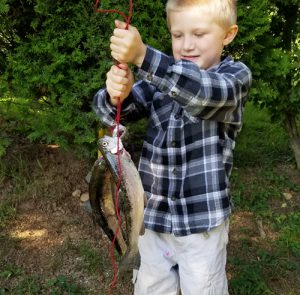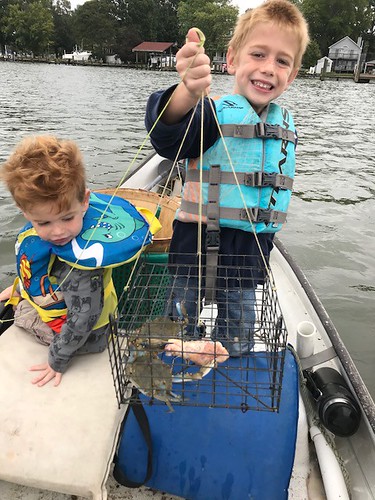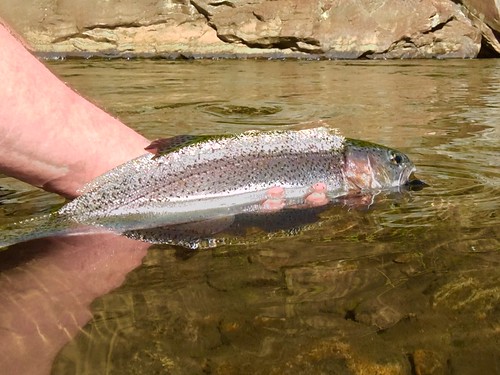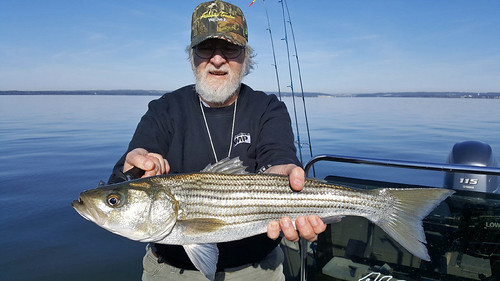Weekly Fishing Report: October 25

Waylon, age 4 sure is happy with his stringer of trout; photo by Harry Wachter.
It seems hard to believe but the month of October is slipping away and November is just around the corner. Temperatures continue to be somewhat mild, and it is a wonderful time to take the young ones out fishing after school or on the weekends.
The fall trout stocking program for October is almost over; these put-and-take areas offer some of the best opportunities for young anglers to enjoy success. Many thanks to the efforts of the trout hatchery and stocking biologists.
Before we get into this week’s fishing report, I wanted to remind everyone that they can submit their own fishing reports and photos to the Maryland Angler’s Log. To post a report, please email your name, hometown, photos, location information and additional content for your report. All information is optional, but encouraged. New reports are posted daily during the busy fishing seasons.
Cooler nights are finally beginning to push water temperatures in the tidal rivers below the 70 degree mark. This has been a long-delayed process due to lingering warm weather, but hopefully things will start to kick into gear. Colder water temperatures in the tidal rivers tend to drive schools of bait in the form of bay anchovies, menhaden and silversides out into the Chesapeake Bay. In about a month, young-of-the-year river herring and hickory shad will also be exiting the tidal rivers, headed down the bay and out into the ocean. Several year classes of striped bass will be waiting along channel edges where swift currents push these schools of bait.
In the upper bay region, there has been good fishing for striped bass chasing bait at the mouths of the Chester, Magothy and Patapsco rivers, as well as around Hart-Miller Island. Casting topwater lures and sassy shads on a jig head have been very popular when targeting breaking fish this week. Suspended striped bass are being found holding close to the bottom along steep channel edges at Love, Podickory and Swan points. This is a great setup for vertical jigging, soft plastic or metal jigs.
Trolling is always an option, and bucktails dressed with twistertails, small spoons, swim shads and surge tube lures are all good choices to troll close to the bottom. Reports this week did not paint a very bright picture for trolling success in the upper bay.
 We have not heard of any reports of spot being found in the typical locations in the upper bay this week, so live-lining is coming to an end. There are always opportunities to live-line small eels around the Bay Bridge and Key Bridge piers, as well as deep edges near Hart-Miller and Pooles islands.
We have not heard of any reports of spot being found in the typical locations in the upper bay this week, so live-lining is coming to an end. There are always opportunities to live-line small eels around the Bay Bridge and Key Bridge piers, as well as deep edges near Hart-Miller and Pooles islands.
Fishing for white perch has been good near deeper areas along shorelines such as piers and deeper areas in the tidal rivers. Bottom rigs baited with bloodworms or dropper flies on a rig are good ways to catch them. Some large white perch are also being caught by those jigging for striped bass with smaller metal jigs.
The middle bay region is starting to see good striped bass fishing in the lower ends of the region’s tidal rivers. Schools of bait can be seen moving out into the bay in the Choptank, Eastern Bay, Little Choptank, Severn and West rivers. Many of the striped bass are undersized, but there are larger ones mixed in. Casting to breaking fish is always fun with topwater lures or soft plastic swim shads. It is also a great time to break out the fly fishing gear and cast skipping bugs. I happened to be out on the Lower Choptank Sunday evening, and boats were grouped up jigging under birds in the channel while others were trolling swim shads and bucktails along river edges in about 15-20 feet of water with some success.
The shallow water fishery for striped bass has been fairly good in the early morning and late evening hours when a good tide is running. Topwater lures on spinning tackle or skipping bugs on fly casting outfits always provides plenty of entertainment. Water temperatures have dipped into the high 60s, so striped bass feel comfortable in shallower water depths.

Taking his grandsons out for one more outing, it would appear that they had a ball; photo by Jim Livingston.
Fishing for white perch remains good, and some large ones are being caught on deep oyster bottom in the lower sections of the tidal rivers. Bloodworms on a simple bottom rig or jigging with dropper flies or metal jigs work well. There are a few spot to be found on hard bottom, but catches are getting slim. The few valuable spot that are caught are being live-lined at the channel edges of the False Channel and Diamonds with good results.
Spot are still being found in the lower bay region, including the Tangier Sound area, Cornfield Harbor near Point Lookout and Point No Point, but the end of this fishery is very near. Spot are being successfully live-lined along the 35-foot edge off Cove Point; the steep edges in the lower Potomac near St. Georges Island and Piney Point for a nice grade of striped bass.
Those bottom fishing are also catching some sea trout, and fishing for white perch has been excellent. Bottom rigs baited with bloodworms have been the most popular way to fish. Deeper hard bottom areas in the tidal rivers have been the best places to find white perch.
There has been good fishing for striped bass in the lower Potomac and Patuxent rivers by casting topwater lures at breaking fish or by casting to shoreline structure in the morning and evening hours. On the eastern side of the bay, a mix of speckled trout, striped bass and a few puppy drum are being caught along the marsh edges and creek mouths.
Cooling water temperatures are having the same cooling effect on recreational crabbing. The lure of one more batch of crabs keeps many out on nice days, setting a trot line or a string of collapsible crab traps. Deeper waters in the 15-20 feet range tend to offer the best catches, and razor clams continue the bait of choice. Sooks are a-plenty and are chewing up baits, which is to be expected this time of the year. The middle and lower bay regions offer the best hope of putting together a catch.
Here is your Weekly Fishing Conditions Forecast Summary from the Click Before You Cast Crew.
(Oct. 25-Nov. 1)
With Halloween just around the corner, not only are we are seeing more pumpkins, but also less daylight, cooler temperatures and improving fishing conditions. Main bay temperatures have cooled slightly to 66-68 degrees.
Expect unstable weather patterns for the next week. Conditions will be sunny but cool (mid- to upper 60s day, 40-50s night) with breezy conditions Wednesday through Thursday. Warmer Saturday (70s) before temperatures cool Sunday through Wednesday (upper 50s to low 60s). Chance of rain Sunday. These cool, windy conditions will continue to mix bay waters and decrease water temperatures.
Note: Bay monitoring results (surface to bottom oxygen, temperature, salinity, etc.) from the latest cruise (Oct. 23-25) will be available for next week’s report. In the meantime, use the previous surface to bottom water quality conditions as a starting point.
While most waters have adequate oxygen from surface to bottom, start your search just above the “Do not fish below this depth.” In the upper bay near Swan Point (along Tolchester channel) and Baltimore Harbor, avoid fishing depths below 13 feet. At the Bay Bridge on the west side, fish above 20 feet. On the east side of the bridge, don’t fish below 15 feet. From Bloody Point and into Eastern Bay, suitable oxygen can be found above 23 feet. From the Choptank River south, there is plenty of oxygenated water well below 30 feet and in many places, throughout the entire water column.
NEW FEATURE
Water Temperature by Depth helps you identify if there are water temperature differences from the surface down to the “Do Not Fish Below This Depth” layer. You can quickly determine whether the water column has a uniform temperature or if deeper waters are warmer or cooler than surface waters.
For this week, most waters are well mixed and have uniform water temperature from surface down to the maximum fishing depth. However, in the mainstem of the bay from the Little Choptank south to the mouth of the Potomac, maximum fishing depths are running about 2 degrees cooler than surface waters. Expect some reduced water clarity from algal blooms/mats in the Northeast, Bush, Gunpowder, Back and Susquehanna Flats. However, normal flows for streams and rivers entering Maryland’s portion of the bay should not impact water clarity. In addition, there will be decent tidal current conditions this Wednesday and next Tuesday and Wednesday.
For the full weekly fishing conditions summary and more detailed and up-to-date fishing conditions in your area of the bay, be sure to check out Eyes on the Bay’s Click Before You Cast. Since this is a new feature for Chesapeake Bay anglers, drop us a note with comments or suggestions.

Taking one last look at this fine rainbow while fishing a streamer fly at the catch-and-release section of the North Branch of the Potomac; photo by Mark Hoekzema.
It is getting colder in the western region of Maryland, and Deep Creek Lake is undergoing some changes. Walleye are starting to school up and steep rocky shores are good places to cast diving jerkbaits and crankbaits. Jig/minnow combinations are also a good bet for a mix of walleye and yellow perch. Crappie are schooling up near the bridge piers of the Route 219 and Glen Dale bridges; yellow perch and walleye can also be found mixed in at times. Jig/minnow combinations are always a good bet as are jigs or minnows under a slip bobber. Smallmouth and largemouth bass are moving into transition areas and watching for crayfish exiting shallower waters looking for deeper structure to hunker down for the winter. Jigs and crankbaits resembling crayfish are good choices to fish these areas.
The fall stockings of trout in the put-and-take areas continues this week and offers good fishing for those looking to take some trout home for dinner. Recently, there was even a stocking in the upper Tuckahoe River on the Eastern Shore and several locations in Prince George’s County. Current stocking information can be accessed at the trout stocking website.
Trout fishermen looking for some fun can try fishing for brown trout in trout management waters, such as the North Branch of the Potomac River. There you will find male brown trout being very aggressive this time of the year, and they will strike large flashy streamer flies, large stonefly patterns and egg patterns.
John Mullican sent in a short report on fishing the upper Potomac this week.
Now is a great time to get out and enjoy the spectacular colors along the Potomac. The river is in great shape for fishing, and the fish are feeding before the hard winter. Smallmouth bass are plentiful and are using shallow rock and boulder habitat. Crayfish are abundant in this habitat, and many of the smallmouth we have collected during our surveys have been stuffed with the crustaceans. Try small crankbaits with frequent pauses; most fish will take the lure on the pause. Hair jigs, tubes and grubs will be effective right through the winter. As the water gets colder, smallmouth bass will move to areas of reduced current.
Largemouth bass that reside in the many ponds, lakes, reservoirs and tidal rivers in Maryland are feeling the urge to actively feed to build up body fat stores for the winter months ahead. The thick grass beds commonly found in the shallower areas are declining due to shorter daylight periods. These grass beds provide cover for a variety of bait items that must now find new places for cover. One of the critters seeking deeper cover for the winter are crayfish, which are a favorite meal for largemouth bass. Largemouth bass can be found holding in transition areas between the shallow and deep areas waiting for crayfish to scurry for deeper cover. Hair jigs, small crankbaits and craws are all good baits to use in this situation. Baitfish will also have the same problem of diminishing cover and casting spinnerbaits and small jerkbaits on the outside edges of cover can be a good tactic. When fishing tidal rivers, a low ebbing tide can often offer the very best opportunities.
Crappie are schooling up near deep cover as water temperatures cool. Fallen treetops, marina piers and bridge piers can often provide excellent fishing for crappie. The crappie will be tight to cover and small jigs, tubes and minnows under a slip bobber is an excellent way to target them.
Blue catfish are very abundant in the lower Potomac River from the Wilson Bridge down to the Route 301 Bridge with the Fort Washington to Indian Head being an area of greatest concentration. Most any kind of fresh cut bait will due on a simple bottom rig along channels of the river. The Patuxent River also has an expanding population of blue catfish as does the Nanticoke River. Channel catfish can be found in most tidal rivers leading into the Chesapeake Bay, and the lower Susquehanna River below the Conowingo Dam has an expanding population of flathead catfish as well as excellent fishing for channel catfish.
In the Ocean City area cooler, water temperatures are beginning to have an effect on local fishing. In the surf, kingfish are becoming less common, small bluefish are being caught on cut bait or finger mullet. At the inlet, tautog are common now, but unfortunately, the throwback ratio is fairly high. Sheepshead are still common at the south jetty, and some really nice ones are being caught on sand fleas and pieces of green crab.
Flounder fishing has been excellent in the channels leading toward the inlet and the inlet itself. Many are using live bait such as spot, small menhaden and mullet to catch the largest flounder. The next week or so presents perhaps the best flounder fishing opportunities of the season. A few sea trout and puppy drum are also being caught.
Outside the inlet, flounder are being found on the inshore shoal areas. The boats targeting sea bass have been doing very well with limit catches being common. The Great Eastern Reef, the African Queen and the Delaware-New Jersey-Maryland Reef have been a few of the locations being targeted. Many of the anglers fishing these reefs and wreck sites are also limiting out on flounder and catching a mix of ling, tautog and triggerfish.
Those venturing out to the canyons are finding sparse pickings and coming back to the dock with mostly chicken dolphin and a few yellowfin tuna. Deep drop fishermen are catching a mix of tilefish.
“There are days when the fishing is better than one’s most optimistic forecast; others when it is far worse. Either is a gain over just staying home.” -Roderick Haig-Brown
 ABOUT THE AUTHOR Keith Lockwood has been writing the Fishing Report since 2003 and has had a long career as a fisheries research biologist since 1973. Over the course of his career he has studied estuarine fishery populations, ocean species, and over a decade long study of bioaccumulation of chemicals in aquatic species in New Jersey. Upon moving to Oxford on the eastern shore of Maryland; research endeavors focused on a variety of catch and release studies as well as other fisheries related research at the Cooperative Oxford Laboratory. Education and outreach to the fishing public has always been an important component to the mission of these studies. Keith is an avid outdoorsman enjoying hunting, fishing, bird dogs, family and life on the eastern shore of Maryland.
ABOUT THE AUTHOR Keith Lockwood has been writing the Fishing Report since 2003 and has had a long career as a fisheries research biologist since 1973. Over the course of his career he has studied estuarine fishery populations, ocean species, and over a decade long study of bioaccumulation of chemicals in aquatic species in New Jersey. Upon moving to Oxford on the eastern shore of Maryland; research endeavors focused on a variety of catch and release studies as well as other fisheries related research at the Cooperative Oxford Laboratory. Education and outreach to the fishing public has always been an important component to the mission of these studies. Keith is an avid outdoorsman enjoying hunting, fishing, bird dogs, family and life on the eastern shore of Maryland.
Want the Weekly Fishing Report sent right to your inbox? Click here to sign up!




 1-888-373-7888
1-888-373-7888 233733
233733